Pumpernickel is a bread with a wonderful muted sweetness that comes from brown sugar and unsweetened cocoa powder. It's unbelievably hearty - one slice in the morning keeps me going through to lunch - and makes for great sandwich bread or toast. This recipe makes 2 pounds of bread - enough for two pretty good sized loaves.
- 2 cups warmed milk (not too hot)
- 2 tbsp vegetable oil
- 4 tbsp molasses
- 3 1/4 cups whole wheat flour
- 1 1/3 cups rye flour
- 1/2 cup cornmeal
- 1 1/3 tsp coarse salt
- 2 2/3 tbsp active dry yeast
- 4 tbsp unsweetened cocoa powder
- 2 2/3 tbsp dark brown sugar
- OPTIONAL: 1 tbsp coffee grounds
Start off mixing the dry ingredients together (as always). Once you've mixed together the whole wheat flour, rye flour, cornmeal, salt, yeast, cocoa powder, and brown sugar (and coffee grounds, if you're feeling kind of crazy), make a well in the center of the dry ingredients and pour in the oil first, then the molasses, then the warmed milk. (Tip: use the same tablespoon for the oil and the molasses - oil first, molasses second. The oil will coat the spoon and make it so you get all of that molasses-y goodness without getting your fingers or mixing spoon sticky.)
Time to mix! If you have a fancy standing mixer (KitchenAid or the like), then this is a really easy step for you. If you're like me and live without such luxuries, start with the spoon or spatula you used to mix the dry ingredients to get a rough dough. Now it's time to dig in with your hands. Start by grabbing some of the mixture with your two hands and mush it together till you have a wet, sticky, but pliable dough. Keep adding more and more of the mixture until you have something you can easily identify as bread dough. (Just in case, I've included a photo of what it should look like.)
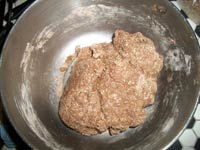
Set the bowl aside and wash your hands; you'll want squeaky clean hands for kneading. Find an empty spot of counter-top, clean it, cover it lightly with some of the whole wheat flour, then turn the dough out and start to knead. Pumpernickel dough is extremely heavy and thick, as you may have noticed, so you might work up a little sweat kneading your dough. That's okay. Embrace the work. You'll have the most beautiful forearms in the world.
I sometimes find this recipe turns out a wet dough, and so I knead in about a quarter to half cup of whole wheat flour. If you find your dough is too dry, add half a teaspoon of milk while kneading. If that's not enough, add another half a teaspoon. Don't add the whole teaspoon at once, because that might make your bread too wet, which means you'll have to knead in more flour, which is time consuming and frustrating.
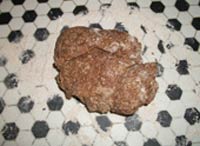
Because the dough is so thick, you only need to knead it for about 10 or 15 minutes. When you're finished, your hands should be kind of oily and you should have a beautiful brown hunk of pumpernickel dough.
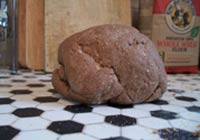
Leave it be on the counter. Get out a big bowl and lightly oil it: pour about two teaspoons of vegetable oil in the bowl and swirl it around inside. Then place your dough hunk inside and cover it all over with the oil. Cover the bowl with plastic wrap, go watch some TV, and come back in about 30 minutes. Your dough should have gotten bigger! Punch it down. Since the dough is so dense, this shouldn't have too much of an effect on the size.
Split the dough into two equal parts.
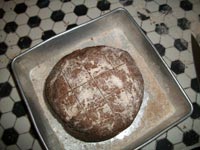
If you're putting your dough in a loaf pan, now's the time to grease and flour that pan and shape your dough to fit it. Mind, this recipe makes enough for two loaves: if you put all of your dough in one pan, it will overflow as it starts to rise and expand. That is not a fun mess to clean up.
However, as you can see, I did not use a loaf pan for this bread: I put one of my two dough-balls in a square, 9x9 pan. This pan is big enough to contain the dough as it expands and not affect the shape of the bread in any way. If you want a round loaf, you can do what I did, or you can put it on a cookie sheet, or if you're fancy, you can put the bread directly on a baking stone if you have one.
Once you've got your dough nicely settled in whatever vessel it shall be baked in, cover it with a damp cloth (use warm water for this). Walk away for another hour, then come back. It's almost time to bake. Turn your oven on to 375 degrees.
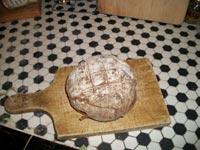
Now this is my favorite part: scoring. Take a pinch of flour and dust the top of your dough, then grab a sharp knife and make a few shallow cuts on the top of the bread. I'm a fan of three vertical, three horizontal cuts, but I've seen tic-tac-toe patterns or just a few slashes across the top. This is more a decorative step, so do whatever pleases you aesthetically.
Pop your loaves in the oven, set the timer to 40 minutes, and voila, my friends: homemade pumpernickel bread. Let it cool for a little bit on a cooling rack.







